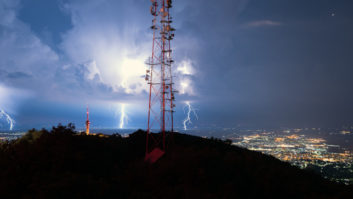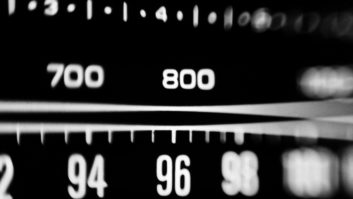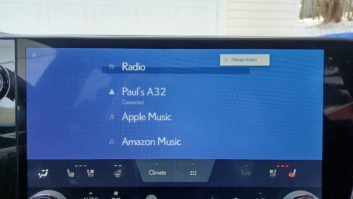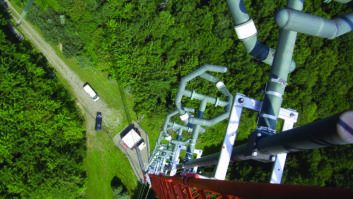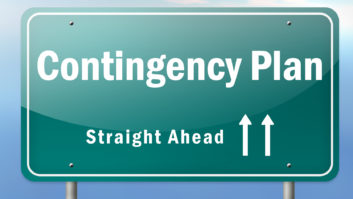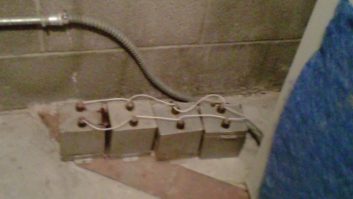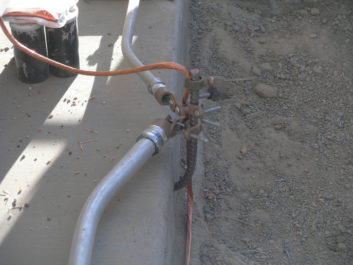
The worst lightning damage I ever saw happened in the month of February; and it was, in more than one sense, a perfect storm.
We were in the process of upgrading our Detroit FM facility, replacing a 1985-vintage Continental 27.5 kW transmitter with a much newer version of the same transmitter. The aux had long been an RCA BTF20, and our chief engineer had pulled it out of service in preparation for installing the new rig.
The new transmitter was at the site and still on the skid and wrapped in plastic. In other words, we had no working auxiliary transmitter.
In February in Michigan, we’re usually much more concerned about snowstorms and antenna icing than lightning; but this particular year, a warm weather system moved through and fired off a line of severe thunderstorms.
Vaporized
At that time I had been with the company for about a decade, and I was well acquainted with the propensity of that particular tower, a 500-foot Pirod free-standing Detroit landmark, to take “grand mal” lightning hits.
I had done everything I knew at the time to mitigate that. I had an array of ground rods at the tower base, and all transmission lines were bonded to that array where they departed the tower. It had been a good while since we’d taken a hit that produced damage.
When the storm system came through, BOOM! The tower took one of those grand mal hits, and the station was knocked off the air.
The air staff called the engineer, who took one look at the situation and called me. I caught the next flight from Dallas to Detroit.
Looking at the Continental transmitter, I couldn’t believe my eyes.
Those familiar with that design know that it has two rows of seven panel-mount fuse holders in the middle of the front panel of the rightmost (power supply) cabinet. Every one of those fuse holders was … gone! Vaporized!
Looking behind the panel, the wires, some not in too good a shape, were still there, the ends turned into beads where the copper strands had melted.
It didn’t take me long to make an executive decision. There was no telling what other damage there was inside that transmitter, so for the moment I forgot about it and focused on getting the new-on-the-skid transmitter connected and running.
That took a few hours, and it wasn’t the prettiest installation, but it got the station back on the air.
Thankfully there was no other significant damage to studio equipment, although as I recall, a good bit of ancillary equipment in the transmitter room was blasted to smithereens and had to be replaced or bypassed.
Missing Connection
With that done, I started doing a post-mortem of sorts to try to figure out what had happened. After all, if it happened once, it could happen again.
I found that the strap connecting the main 3-1/8-inch rigid transmission line to the station reference ground (that array of rods I mentioned earlier) had been severed. Lightning evidently had hit the main antenna, which is on a pole on the top of the tower, and the current travelled down the rigid line right to the older Continental transmitter.
Some of the current no doubt flowed through the tower structure to ground, but evidently the path to ground through the transmitter cabinet had a much lower impedance.
The transmitter cabinet was connected to a safety ground that was eventually tied to the service entrance ground and whatever ground Edison provided. And evidently, enough potential was developed across the Bakelite (or whatever the material) panel-mount fuse holders that they vaporized. I found pieces of those fuse holders on the floor several feet from the front of the transmitter.
[Subscribe to Radio World Engineering Extra]
One side of most, if not all, of those fuses was connected directly to the incoming AC power phases, and (again, evidently) those phase conductors, which were shunted to ground with an LEA-Dynatech lightning suppressor, presented a lower impedance to ground than the safety ground on the transmitter cabinet. All the grounds were at one time tied together, but in the process of uninstalling the old RCA aux, somehow one critical ground conductor was disconnected.
We wasted no time repairing the broken strap that gave lightning current a place to jump off transmission lines before entering the building, and we brought in an electrician and had him bond all the grounds together so that the tower ground, station reference ground, service entrance ground and lightning suppressor ground were all at the same potential.
I can’t remember what all was blasted in that Continental transmitter, but we did fix it and it saw many years in auxiliary service.
Now Is the Time
The point of this sordid account … well, there are a couple of points.
First, a lightning hit can happen at any time, during just about any month of the year.
In Colorado where I live, we sometimes experience a phenomenon called “thundersnow,” where we get lightning and thunder during snowstorms. I’ve never experienced that anywhere else, but my guess is that it’s not uncommon anywhere it snows. Everywhere else, a passing weather system can fire off lightning just about anytime.
Next, the best way to prevent lightning damage is to give lightning a place to go other than into or through your equipment.
That means a jumping-off point where transmission lines, power conductors and control cables leave the tower. It also means a low-impedance ground, which is more easily achieved in some locations than others. Some soil types may require chemical rods (which you have to maintain). And it means keeping all grounds at the same potential, with heavy-gauge wire used to connect rods and bond everything together.
There are a lot of good resources out there dealing with lightning protection, including NFPA780, which is the National Fire Protection Association’s “Standard for the Installation of Lightning Protection Systems.”
Radio World has an excellent ebook available titled “Is Your Transmitter Ready for Lightning Season?”
Broadcast Engineering Conference papers have been presented on the topic. And of course there’s an excellent chapter on the topic in the 11th Edition of the NAB Engineering Handbook. A search of the internet will turn up numerous other resources.
Whether or not you get lightning in your area outside the usual thunderstorm season, now is the time to inspect your facilities and prepare. Forewarned is forearmed.
We still get the occasional lightning strike on that Detroit tower — we have experienced two in the past 12 months — but we seldom see any direct damage. Our excellent engineering staff in Detroit is well aware of the potential (no pun intended) for damage and makes a visual inspection of the entire ground system, including transmission line bonds, part of their routine.
That kind of thing should be part of every broadcast engineer’s routine, especially as we head into thunderstorm season.
In the new issue of Radio World Engineering Extra, Wayne Eckert, who spent many years protecting AT&T sites from lightning damage, will offer tips so that you can apply some of his techniques to broadcast studio and transmitter facilities. We would do well to pay attention to what he has to say.
Cris Alexander, CPBE, AMD, DRB, is director of engineering for Crawford Broadcasting. Email him at [email protected].





